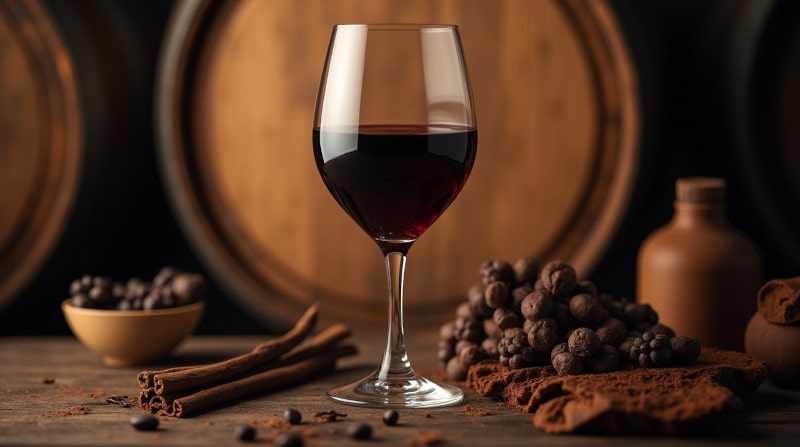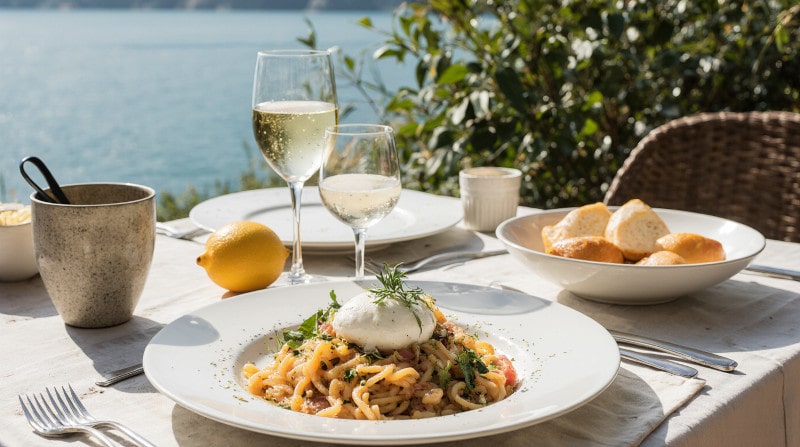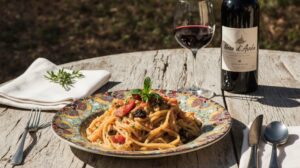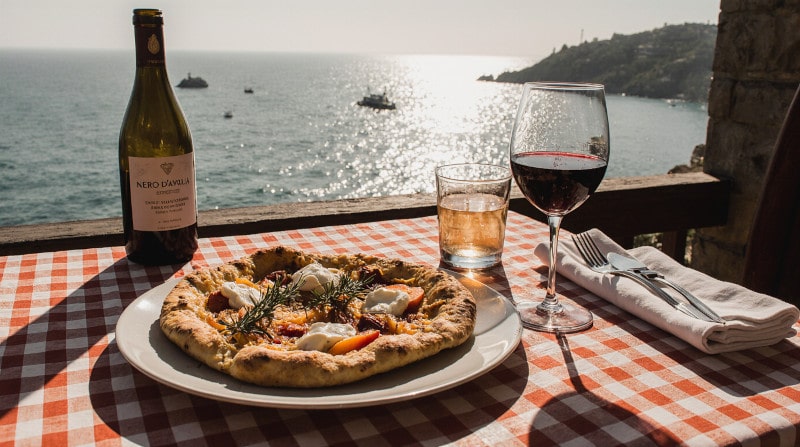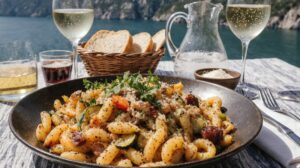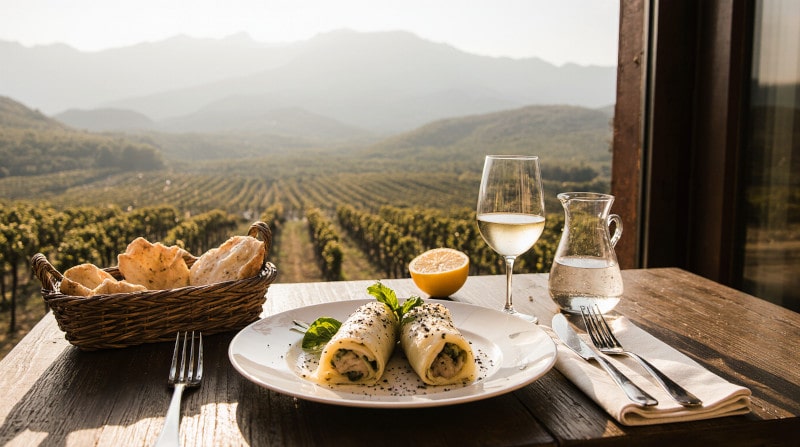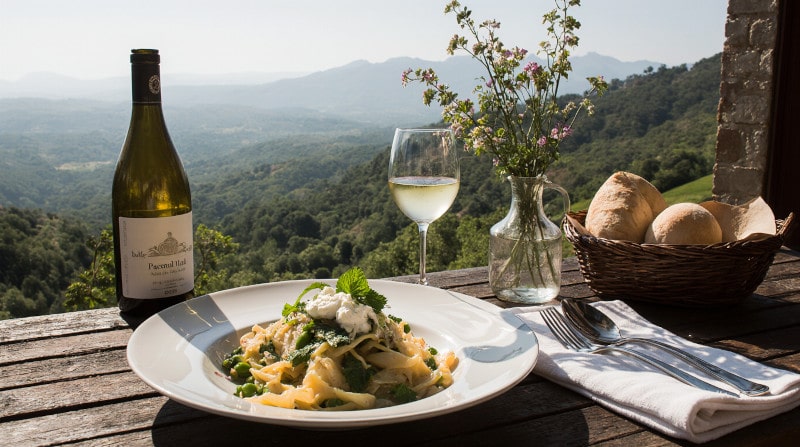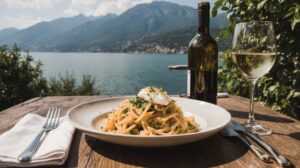How wine develops its character
very wine has a unique personality – shaped by a variety of factors that influence its taste, structure and aroma. These factors are decisive for how a wine harmonizes with food and how it is perceived when paired. Acidity, tannins, residual sweetness, alcohol, ageing in wooden barrels and minerality are just some of the elements that determine how a wine tastes and which foods go best with it.
In this section, you will find out which influencing factors play a role in wine and how they affect wine pairing.
1. acidity – freshness and liveliness in the wine
Acidity is one of the most important components of a wine, as it lends freshness and influences the taste of food. It provides a lively mouthfeel and makes wines particularly refreshing.
Typical wines with high acidity:
- Riesling
- Sauvignon Blanc
- Grüner Veltliner
- Champagne & sparkling wines
- Chianti (Sangiovese)
Influence on pairing:
- High acidity in the wine balances out fatty dishes → A tangy Riesling harmonizes perfectly with fried fish or cheese fondue.
- Acidity in the wine must match the acidity in the food → A dish with lemon juice or vinegar requires a wine with similar acidity, otherwise the wine will appear stale (e.g. Sauvignon Blanc with ceviche).
- Acidity enhances the perception of salt → This is why a mineral Chablis goes perfectly with oysters or salty seafood.
2. tannins – structure and tannins in wine
Tannins are plant-based tannins that are mainly found in red wines and give them a dry, slightly furry feel on the tongue. They come from the grape skins, seeds and stems or from ageing in wooden barrels.
Typical wines with high tannins:
- BeefCabernet Sauvignon
- Nebbiolo (Barolo)
- Malbec
- Syrah/Shiraz
- Bordeaux wines
Influence on pairing:
- Tannins react with proteins and fat → Strong red wines with lots of tannins go perfectly with protein-rich dishes such as steak, lamb or mature cheese.
- Bitterness in food increases tannins → Be careful with bitter vegetables such as artichokes or rocket – they can make a tannin-rich red wine appear unpleasantly bitter.
- Tannins mellow with fatty or creamy dishes → A Barolo with creamy risotto or a Cabernet Sauvignon with a fatty ribeye steak are classic pairings.
3. residual sweetness – the balance between sweetness and acidity
The residual sweetness in a wine is caused by the sugar in the grapes that has not fully fermented and has a significant influence on how the wine goes with certain dishes.
Typical wines with residual sweetness:
- Riesling Spätlese & Auslese
- Moscato d’Asti
- Gewürztraminer
- Tokay
- Port wine
Influence on pairing:
- Sweetness softens spiciness in dishes → A semi-dry Riesling or Gewürztraminer goes perfectly with spicy Thai or Indian food, as the sweetness softens the spiciness.
- Residual sweetness harmonizes with sweet dishes → A wine must be at least as sweet as the dessert, otherwise it will seem sour. Example: Sauternes with crème brûlée.
- Sweetness enhances umami-rich flavors → A matured Riesling can be wonderfully combined with matured cheese, as sweetness and umami complement each other.
4. alcohol content – body and intensity in the wine
The alcohol content of a wine influences how it is perceived in the mouth and can either lend fullness or enhance the spiciness of food.
Typical wines with a high alcohol content (> 13.5%):
- Amarone della Valpolicella
- Californian Zinfandel
- Shiraz from Australia
- Châteauneuf-du-Pape
Influence on pairing:
- High alcohol increases spiciness in food → Spicy food (e.g. chili dishes) should not be combined with high-alcohol wines, as this increases the burning sensation.
- Alcohol supports the perception of sweetness → A strong Amarone can harmonize wonderfully with dark chocolate.
- Alcohol brings richness and depth → This is why high-alcohol wines often go well with intense, full-bodied dishes such as game stews or BBQ.
5. wood maturation – influence of barrique & roasted aromas
Many wines are matured in oak barrels (barriques), which gives them additional aromas and a softer tannin structure.
Typical wines aged in wooden barrels:
- Chardonnay from Burgundy or California
- Bordeaux (Cabernet Sauvignon, Merlot)
- Rioja (Tempranillo)
- Brunello di Montalcino
Influence on pairing:
- Roasted flavors complement grilled meat & BBQ → A wood-aged Malbec goes perfectly with a grilled steak.
- Vanilla and coconut notes in white wines → Chardonnay from the barrique is ideal with creamy dishes such as Pasta Alfredo.
- Too much wood can mask subtle aromas → Light, delicate dishes (e.g. sushi) should not be paired with wines that are heavily aged in wood.
6. minerality – a subtle but important factor
Some wines have a pronounced mineral note, which manifests itself as a salt or flint aroma. This is typical of wines from certain soils (e.g. slate, limestone).
Typical mineral wines:
- Chablis (Chardonnay)
- Riesling from the Moselle
- Albariño from Spain
- Etna wines from Sicily
Influence on pairing:
- Mineral wines go well with salty dishes → A Chablis harmonizes perfectly with seafood and oysters.
- Stony, smoky notes in wines enhance umami-rich dishes → A Silvaner with minerality goes well with mushroom dishes or smoked fish.
Conclusion: The right choice for perfect wine pairing
The various influencing factors of a wine determine how well it harmonizes with certain dishes. Understanding these factors helps to create deliberate and exciting pairings. Whether acidity, tannin, alcohol or wood – each element contributes to finding the perfect wine for your dish.
🍷 Use this knowledge to make your wine pairings even more sophisticated!

